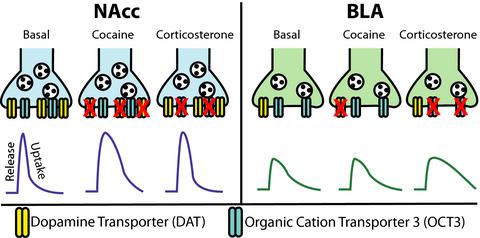当前位置:
X-MOL 学术
›
Eur. J. Neurosci.
›
论文详情
Our official English website, www.x-mol.net, welcomes your
feedback! (Note: you will need to create a separate account there.)
Organic cation transporter 3 and the dopamine transporter differentially regulate catecholamine uptake in the basolateral amygdala and nucleus accumbens.
European Journal of Neuroscience ( IF 2.7 ) Pub Date : 2020-07-29 , DOI: 10.1111/ejn.14927 Katherine M Holleran 1 , Jamie H Rose 1 , Steven C Fordahl 1 , Kelsey C Benton 2 , Kayla E Rohr 2 , Paul J Gasser 2 , Sara R Jones 1
European Journal of Neuroscience ( IF 2.7 ) Pub Date : 2020-07-29 , DOI: 10.1111/ejn.14927 Katherine M Holleran 1 , Jamie H Rose 1 , Steven C Fordahl 1 , Kelsey C Benton 2 , Kayla E Rohr 2 , Paul J Gasser 2 , Sara R Jones 1
Affiliation

|
Regional alterations in kinetics of catecholamine uptake are due in part to variations in clearance mechanisms. The rate of clearance is a critical determinant of the strength of catecholamine signaling. Catecholamine transmission in the nucleus accumbens core (NAcc) and basolateral amygdala (BLA) is of particular interest due to involvement of these regions in cognition and motivation. Previous work has shown that catecholamine clearance in the NAcc is largely mediated by the dopamine transporter (DAT), but clearance in the BLA is less DAT‐dependent. A growing body of literature suggests that organic cation transporter 3 (OCT3) also contributes to catecholamine clearance in both regions. Consistent with different clearance mechanisms between regions, catecholamine clearance is more rapid in the NAcc than in the BLA, though mechanisms underlying this have not been resolved. We compared the expression of DAT and OCT3 and their contributions to catecholamine clearance in the NAcc and BLA. We found DAT protein levels were ~ 4‐fold higher in the NAcc than in the BLA, while OCT3 protein expression was similar between the two regions. Immunofluorescent labeling of the two transporters in brain sections confirmed these findings. Ex vivo voltammetry demonstrated that the magnitude of catecholamine release was greater, and the clearance rate was faster in the NAcc than in the BLA. Additionally, catecholamine clearance in the BLA was more sensitive to the OCT3 inhibitor corticosterone, while clearance in the NAcc was more cocaine sensitive. These distinctions in catecholamine clearance may underlie differential effects of catecholamines on behavioral outputs mediated by these regions.
中文翻译:

有机阳离子转运蛋白 3 和多巴胺转运蛋白差异调节基底外侧杏仁核和伏隔核中儿茶酚胺的摄取。
儿茶酚胺摄取动力学的区域变化部分是由于清除机制的变化。清除率是儿茶酚胺信号强度的关键决定因素。由于这些区域参与认知和动机,伏隔核核心 (NAcc) 和基底外侧杏仁核 (BLA) 中的儿茶酚胺传递特别令人感兴趣。以前的工作表明,NAcc 中的儿茶酚胺清除主要由多巴胺转运蛋白 (DAT) 介导,但 BLA 中的清除较少依赖于 DAT。越来越多的文献表明,有机阳离子转运蛋白 3 (OCT3) 也有助于这两个区域的儿茶酚胺清除。与区域之间不同的清除机制一致,NAcc 中儿茶酚胺的清除速度比 BLA 中更快,尽管这背后的机制尚未得到解决。我们比较了 DAT 和 OCT3 的表达及其对 NAcc 和 BLA 中儿茶酚胺清除的贡献。我们发现 NAcc 中的 DAT 蛋白水平比 BLA 中的高约 4 倍,而两个区域之间的 OCT3 蛋白表达相似。脑切片中两种转运蛋白的免疫荧光标记证实了这些发现。体外伏安法表明,NAcc 中儿茶酚胺释放的幅度更大,清除率比 BLA 更快。此外,BLA 中的儿茶酚胺清除率对 OCT3 抑制剂皮质酮更敏感,而 NAcc 中的清除率对可卡因更敏感。
更新日期:2020-08-19
中文翻译:

有机阳离子转运蛋白 3 和多巴胺转运蛋白差异调节基底外侧杏仁核和伏隔核中儿茶酚胺的摄取。
儿茶酚胺摄取动力学的区域变化部分是由于清除机制的变化。清除率是儿茶酚胺信号强度的关键决定因素。由于这些区域参与认知和动机,伏隔核核心 (NAcc) 和基底外侧杏仁核 (BLA) 中的儿茶酚胺传递特别令人感兴趣。以前的工作表明,NAcc 中的儿茶酚胺清除主要由多巴胺转运蛋白 (DAT) 介导,但 BLA 中的清除较少依赖于 DAT。越来越多的文献表明,有机阳离子转运蛋白 3 (OCT3) 也有助于这两个区域的儿茶酚胺清除。与区域之间不同的清除机制一致,NAcc 中儿茶酚胺的清除速度比 BLA 中更快,尽管这背后的机制尚未得到解决。我们比较了 DAT 和 OCT3 的表达及其对 NAcc 和 BLA 中儿茶酚胺清除的贡献。我们发现 NAcc 中的 DAT 蛋白水平比 BLA 中的高约 4 倍,而两个区域之间的 OCT3 蛋白表达相似。脑切片中两种转运蛋白的免疫荧光标记证实了这些发现。体外伏安法表明,NAcc 中儿茶酚胺释放的幅度更大,清除率比 BLA 更快。此外,BLA 中的儿茶酚胺清除率对 OCT3 抑制剂皮质酮更敏感,而 NAcc 中的清除率对可卡因更敏感。











































 京公网安备 11010802027423号
京公网安备 11010802027423号